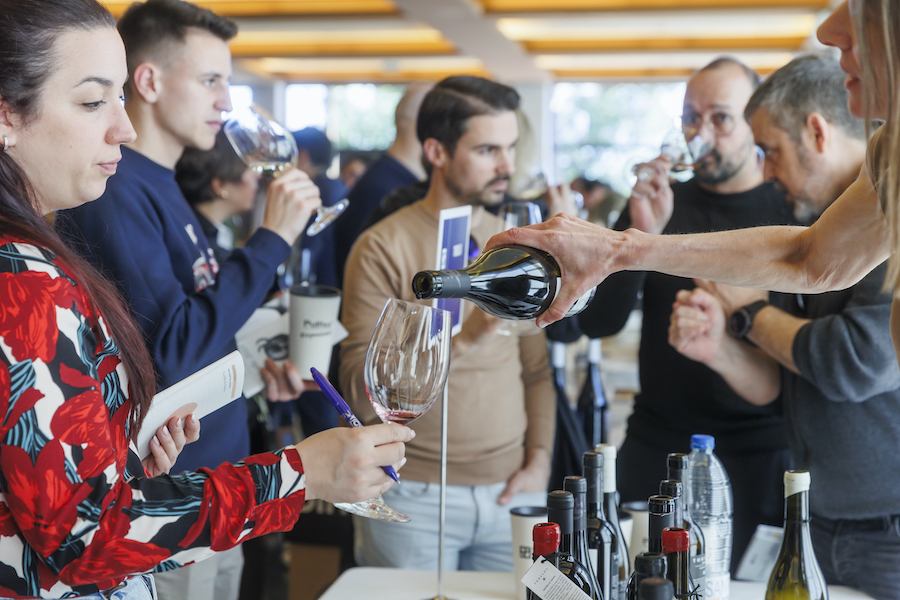
What began as a modest gathering in Logroño to showcase young wines to local hospitality professionals, distributors and enthusiasts has become a fully established wine show. The vintage presentation tasting of Bodegas Familiares de Rioja has just held its 27th edition, with a growing number of participating producers, wine styles and visitors.
This year, 54 wineries took part in the show, grouped by valleys and mountains, out of more than 150 that make up the association. Despite the challenges facing the wine sector - which are not unfamiliar to small producers - the event attracted some 700 professionals and 600 enthusiasts, capturing the growing interest in the tremendous diversity of wines from this appellation, which is celebrating its centenary this year.
‘Rioja deserves to be rediscovered; nowadays it goes far beyond the traditional classification of wines according to their time in oak’, says Ana Jiménez, manager and coordinator of the Association. It was precisely for this purpose that the Argraf Award for the Best Sommelier of the Other Rioja was created, the second edition of which attracted 50 professionals, including sommeliers from Michelin-starred restaurants in northern Spain.
The challenge was not an easy one: in a blind tasting, the contestants had to identify the area of Rioja from which the wines came, their grape varieties and their production methods. Of the 50 participants, 10 reached the final, where Iván Sánchez, sommelier at Venta de Moncalvillo restaurant (one Michelin star in Daroca de Rioja), emerged victorious. He was followed by Ramón González, from Tienda del Vino Matamorosa (Cantabria), and in third place, María Millán, from the Silken Villa Lucía hotel (Laguardia), together with Rubén Jiménez, from Mesón El Charro (Logroño).

As usual, it was impossible to taste all the wines showcased at the event, but these are some of the ones that stood out:
Arizcuren:
The consistency, precision and personality of the wines is improving with each vintage, including 2022, a warm year with significant challenges in terms of the maturity and alcohol content of the wines in practically the whole of Rioja, but with a particular impact in the region of Quel, where Javier Arizuren has his vineyards. We were particularly taken with Mazuelo, from two vineyards at an elevation of about 600 metres in Yerga, and Barranco del Prado, a pre-phylloxera Garnacha planted at 780 metres in sandy soil, which, although rounder than in previous vintages, retains its elegance very well.
Bodegas Forcada:
Founded in 2001, but with four generations dedicated to the vineyard, this winery is located in Rincón de Olivedo, in the Alcarama mountain range, on the southern side of Yerga. With poor, stony soils, they manage 110 hectares of vineyards near this region on the border with Soria, of which 60 are their own. As well as making wine, they also sell grapes. We liked the 2021 vintage of La Forcada, a Garnacha made from 40-year-old vines with a fine balance of ripe fruit, spicy notes and freshness. They produce 20,000 bottles which sell for €18.
Finca Vistahermosa:
Clara Herrero's work in the recovery of the family vineyards, acquired in 2002 in Molinos de Ocón, can be seen in both her old Garnacha and other varieties planted at up to 750 metres elevation. In addition to their food-friendly Conversa Blanco 2021 —a blend of White Tempranillo, White Maturana and skin-fermented Sauvignon Blanc— we were impressed by their Viñedo Singular Cuesta de la Estrella 2022, an old Garnacha fermented in vats and barrels with 15% stems. From a vineyard at 670 metres, only 1,350 bottles are produced, capturing the quality of the fruit in this increasingly valued area of Rioja Oriental.

Ijalba:
Pioneers in the production of the first 100% Graciano in Rioja, this bodega in Logroño has assembled a treasure trove in its vineyard archive, with 70 local grape varieties. They have also led the recovery of the red and white Maturana varieties. Eight hectares are grown with the latter, present in Rioja since the 17th century but almost disappeared until a few years ago. We tasted their 2024 vintage, still young, of which 20,000 bottles are produced. With notes of fresh herbs and a food-friendly palate, it will improve with time in the bottle, as will Ijalba Graciano 2022, fresh and mineral, whose classic varietal structure is softened by the warmth of the vintage.
Tobelos:
Located in Briñas, in Western Sonsierra, this estate has one of the best views of the Conchas de Haro and the Obarenes Mountains. It has 55 hectares divided into 80 plots and also buys grapes from suppliers. This is the case of the Tempranillo for Salinillas de Tobelos, which comes from vineyards in Salinillas, a small village on the northern slope of the Toloño mountain range, within the district of Labastida. The Atlantic influence is perceived in the fresh and spicy character of the wine. We were also intrigued by their Viñedo Singular made from old Garnacha vines, with good freshness, fruity expression and gentle tannins.
Eguíluz:
This was one of our last Wines of the Week, and the truth is that Israel Eguíluz, who represents the younger generation of this family of winegrowers, is making very good progress in interpreting the villages and plots they farm, primarily in Ábalos, where the winery is located, but also in Labastida and Peciña. We particularly liked Las Preferidas Blanco 2023, a blend of 85% Viura and younger vines of Garnacha Blanca aged on lees for eight months. The result is a savoury, balanced wine with a subtle presence of oak that will probably integrate as the wine ages in the bottle. As Amaya pointed out in her article, this is a name to watch.

Yolanda Ortiz de Arri
A journalist with over 25 years' experience in national and international media. WSET3, wine educator and translator
Vega Tolosa Tardana 2023 White
NEWSLETTER
Join our community of Spanish wine lovers






